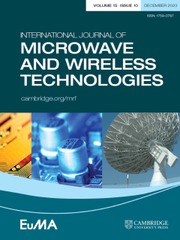No CrossRef data available.
Introduction of the orthogonal mode via the polarization conversion parasitic structure for the isolation enhancement of MIMO patch antennas
Published online by Cambridge University Press: 26 April 2024
Abstract
In this study, a high-isolation multiple-input multiple-output (MIMO) microstrip patch antenna (MPA), which utilizes an orthogonal mode cancellation method is proposed. This method employs TM10 and TM01 modes, which are simultaneously excited in the rectangular passive MPA. Initially, a rectangular decoupling structure featuring polarization rotation characteristics is designed. Further studies show that by loading the polarization conversion parasitic structure (PCPS), the electric field of the spatial coupling wave can be transformed from the x-polarized TM10 mode to the y-polarized TM01 mode. Therefore, TM10 and TM01 modes from the excited antenna and decoupling structure are concurrently coupled to the passive antenna, forming an evident weak-field region on the passive antenna. Placing the feeding probe of the passive MPA within the weak-field region prevents signal reception at the port. Consequently, this results in an extremely low mutual coupling of −49 dB at a resonant frequency of 5.8 GHz. Finally, a prototype of the proposed antenna is fabricated and tested, and the measured results closely match the simulated results. Additionally, it is observed that PCPS slightly influences the performance of the MIMO antenna.
- Type
- Antenna Design, Modelling and Measurements
- Information
- International Journal of Microwave and Wireless Technologies , Volume 16 , Special Issue 5: EuMW 2022 Special Issue , June 2024 , pp. 893 - 901
- Copyright
- © The Author(s), 2024. Published by Cambridge University Press in association with The European Microwave Association.



